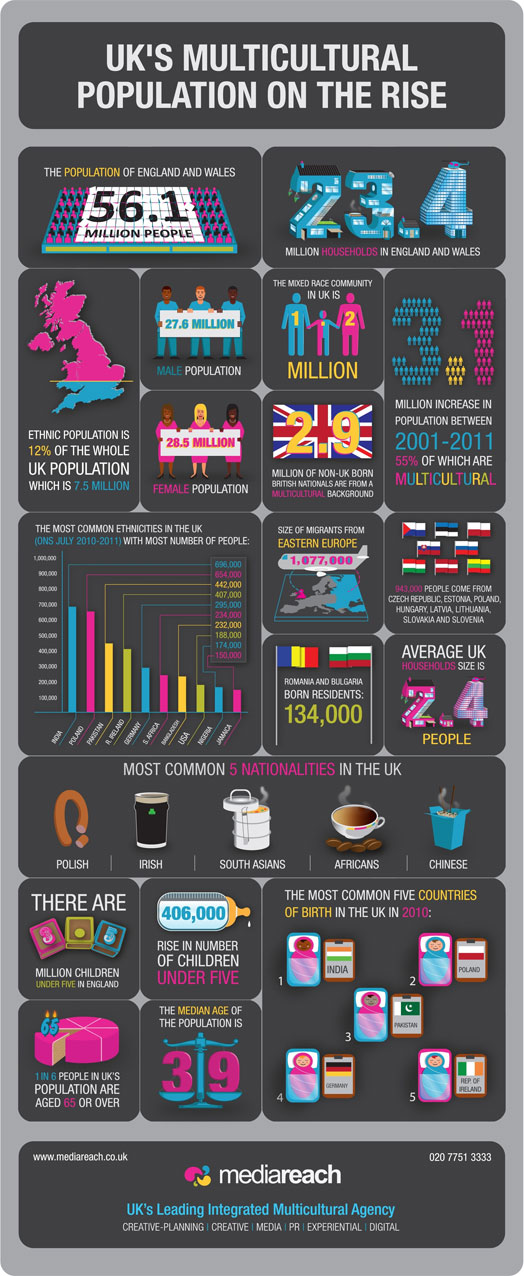The New ONS Statistics Indicate Britain Has the Most Multicultural Population Than Ever
It is not a surprise any more that the multicultural population is growing fast. For many years Mediareach Advertising has been releasing analysis highlighted with data and facts to bring the attention of UK businesses to this important factor of changing demographics. According to the latest ONS statistics, the population has increased by 3.1 million within 10 years. 55% of this 3.1 million increase was attributed mostly to net migration, making the total population 56.1million*. The multicultural population in the whole UK is 7.5 million from which 2.5 million are from Europe and 5 million are from outside Europe. The number of illegal immigrants is not included in any of these figures. The unofficial estimate is around 2 million*.
London has become UK’s economic powerhouse, sucking in people and investments, and is therefore experiencing the largest growth in population, mostly in Tower Hamlets and Newham. East England, East Midlands and Manchester have equally high percentage growths in populations*.
From the business perspective these facts pose great opportunities for finding out where to invest and how to connect more effectively with this multicultural audience, thus topping up the revenues. Businesses can no longer afford to ignore Britain’s multicultural market if they want to strategically grow and increase their market share. We have one of the most diverse cities in the world where this ethnic population has over 300 billion in disposable income. When prices are falling and the economy is hit hard, the main strategy is segmentation and precision marketing. One-size fits all approach loses its relevance. In the cities such as London, 40% of the population is considered to have an ethnic background*. The diversity is what defines us more than ever. In fact, cultural media, community messaging and niche marketing is becoming the conduit of the advertisers’ in-the-know, who have already spotted the value for money and ROI that others are yet to catch onto.
We have been arguing for quite a while that the big increase of multicultural population has not happened just within the last 10 years but over the last 20 years or more*. It is because the previous ONS data failed to show the real figure, missing out a large number of population groups from the census questionnaire, which ONS does not deny. This is another reason why 2011 figures suddenly seemed record high.
Although the figure demonstrates a huge increase in the multicultural population, this is not yet the actual figure. Number of councils has been arguing that the true figure is much higher as the councils have more people registered and paying council taxes than the official figures show.
To add up more analysis for these mismatching of figures is the fact that in 2001-2009 it was revealed that 21% of the UK’s population was multicultural, but 2011 figures showed only 12%. If it is claimed that the multicultural population is growing fast, then the current figure cannot be less than before.
Further shortcoming that have created hot debates is the actual population figure itself. Number of officials and the public contemplate that the realistic figurer is between 56.1 to 63 million. Calculating the number of migrants relies on notoriously unreliable international passenger survey. It gives dodgy data; at least 15% of these people are the ones who decide to leave. A fifth of those people are the ones who travel across the Irish Sea and do not stay in the UK*.
Even without deep analysis you can see the errors in the figures. According to ONS statistics (year ending September 2011), the UK residents who were born aboard were 7.4 million, 5 million from outside Europe and 2.5 million from Europe. These figures when added together should be 7.5 million, not 7.4 million. With just this simple equation, they take 100.000 people out from the count.
The figures show that the number of children under five have increased, however, the census admits that it missed young people aged 10-19 from abroad too*.
These figures will understandably become a battlefield and a ground for boiling arguments on immigration. We would like to emphasise, however, on the actual business case, from purely what is the most beneficial approach for UK’s economy perspective. Limiting immigration is a big economic cost to the country. Last year the Office for Budget Responsibilities has shared an assumption that if net inward migration falls to 140.000 (presently 250.000) and remains there over the next five decades, it would require spending cuts and tax rises of £17billion to bring down the national debt to 40% by 2064. However, if it stays on current rate of immigration and is allowed to continue, that figure will fall to 4.6 billion by 2062*.
The Government will have to make serious choices, boiling down to whether to import growth to the country and businesses through immigration or cut down public spending and raise taxes. The Government has promised to cut down the immigration to the electorate, but is the country and economy ready to pay the cost for it?
Whatever the actual figure, all of the analysis indicates one thing for sure-the multicultural population is increasing fast and it is going to become more visible in the near future. Simply accepting these facts would not be enough. Clever business and marketing strategies have to be developed to be able to connect with the current UK population more effectively, taking into consideration their backgrounds and culture.
Demographics have changed marketing strategies need to reflect this too.


